( Log In ) Log In is for TREC Teachers & Researchers only
  |
| Steve_Marshall |
 Jun 21 2005, 05:31 PM Jun 21 2005, 05:31 PM
Post
#1
|
 TREC Teacher    Group: TREC Team Posts: 78 Joined: 27-April 05 Member No.: 12 |
Sunday 6/19/05 #1
My Personal Ice Liberty As I had mentioned in a previous journal entry, our “ice liberty” where everyone could go out on the ice for some fun in the arctic had been postponed. However, for Glenn Berger and I, we had our own ice liberty of a sort as we were the next scheduled pair to go out on the helicopter to search for dirty ice (ice containing sediments). Before our flight, we had to take part in the flight briefing that is given each time before a helicopter goes up. This briefing was both interesting and a little intimidating at the same time, because the captain, senior officers, flight personnel, etc are all present. It’s interesting because you again hear about all the factors that go into flying: Weather, visibility, ship’s position, objectives, destinations, etc. Almost all of this falls under the interesting category, but the intimidation category comes into play when after summarizing all the conditions, a risk assessment for our flight is given. The risk assessment for our flight was the high end of low. Hmmmm….It’s nice that we’re in the “low” category, but what’s all this about the “high” end of low?? Anyway, we got the go-ahead, so we suited up with all the gear we needed: Steel-toed boots, mustang suit, survival pack, harness (for tethering to when out on ice) , helmet with ear protection and communication equipment. After we were all set, Glenn and I headed to the helicopter. Having only two people in the back was still a little tight, but compared to the three we had when we transferred from Barrow to the ship, this seemed like first-class accommodations! Once settled, the crew (pilot, co-pilot, flight engineer) went through the pre-flight checklist. Again, I’m still amazed at all that goes into a flight. You think it can be started up just like turning the ignition on a car, but it’s much more complicated than that, and instruments must be closely monitored for the proper oil pressure, rotor speed, wind direction, etc. We finally got the green light, though, and took off. Pre-flight Checklist 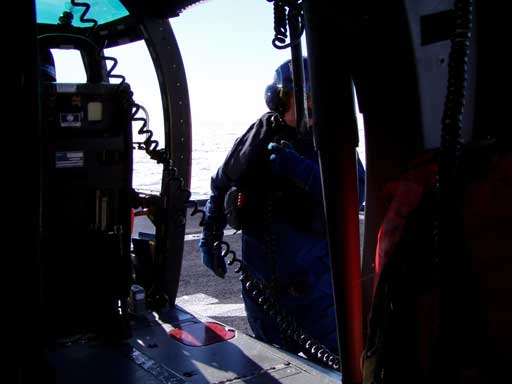 The flight engineer (outside) helps assist the pilot in making sure everything is ready for take-off Counting Down 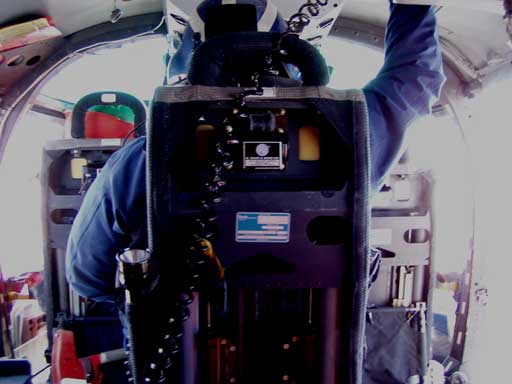 Everyone gets settled as we get ready to lift off Close Quarters 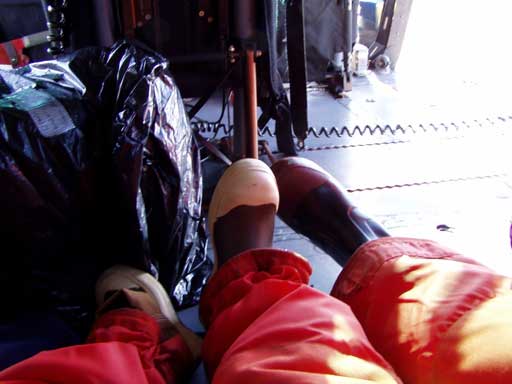 Taking a picture of Glenn and my feet gives some perspective of how tight the space is on the helicopter. Our first priority of this flight was not looking for the dirty ice, but to check out the conditions at the proposed core locations, as well as the path for the ship to get to those locations. This again emphasized all the different parts people and information plays in a successful mission. Obviously the view from the ship is not far enough to assess all the ice conditions, so having aerial information supplied by the helicopter is an invaluable resource for plotting the ship’s direction. The value and importance of GPS was also demonstrated as each point of interest such as an area of thick ice, thin ice, potential dirty ice (for our purposes), could be marked precisely with the GPS coordinates, and then entered into the ship’s computer systems to plot the appropriate course. Open Water  These are the types of things we were looking for to report back to the ship to help it navigate easily to the core sample location site First Core Location 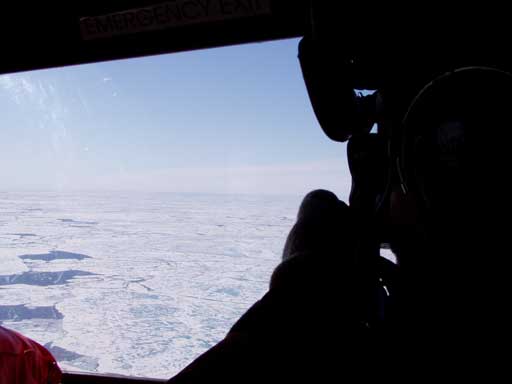 This is an area near the spot where we’re expecting to core. While it’s not as open as some of the other areas we saw, it’s still something that shouldn’t be much of a problem in getting a core. Once the core sample locations were surveyed, we continued on with our mission to find the dirty ice. For this, I was allowed to move forward and look out the side door of the helicopter. To do this, I had to be secured with a gunner’s belt, which again gave me that, “should I be worried by this?” feeling, but the excitement of the whole thing easily put any hint of fear far away in the back of my mind. The views were incredible, and it is so much different than in a plane because we could change altitude very quickly, ranging anywhere from 1000feet to 50feet off the surface, and turns could be so sharp I would feel I was looking straight down at the ground from the side of my window! Nice Lead  The long narrow areas of open waters shown here are what are called “leads.” These are nice to locate to make sailing easier. One other thing for perspective though: Compare this picture where you can easily see the horizon in the window, to the next picture where all you see is ice and water….That means the second picture is one of those “sharp turns” I was writing about! Good Thing the Door’s Closed!  No horizon in view here—That must mean we’re in a sharp turn Air Conditioning 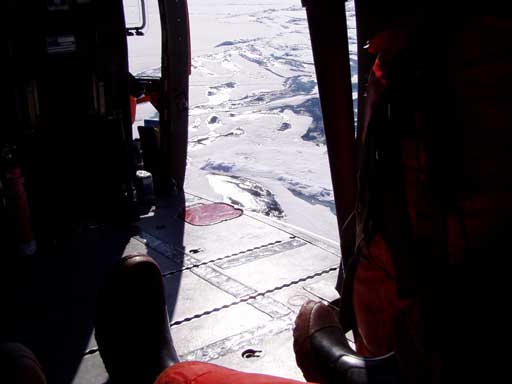 Having an open door always made things interesting too While the sight-seeing was great, we DID have a purpose; We were looking for any signs of sediment in the ice. Because it was so bright today, it seemed as though there were many optical illusions; What looked like dirty ice would actually be either broken up pieces of ice, or a kind of partially melted, slushy snow. Because of this difficulty in determining what we were actually seeing, the pilot decided to land just to make sure. Landing on the ice was another source of some anxiety. Before we could put the weight of the entire helicopter on the ice, the engineer had to get out and hand-drill a hole to determine how thick the ice was. Testing the Ice  It’s a little hard to see here, but the coiled object (not the radio cord) in the engineers hand is a hand-drill that is used to determine the thickness of the ice. Even though it was determined to be safe, when we got out, the snow and ice would still give way a little, creating a slushy puddle. This couldn’t help but make you wonder if this was a good idea or not. To add to the speculation, Glenn and I were tethered together with a rope. I realized that should have made us feel safer, but you still had to wonder… Our Lifeline  A picture of the helicopter (and our lifeline) taken from where Glenn and I are. Look closely at the ice immediately in front of the engineer’s feet, and you should see a discolored area…That is the slush puddle created when we stepped off the helicopter. Interesting feeling. Is This a Good Idea?  Glenn sampling the water and ice. Seems a little close, but we have faith:) Where’s that Fishing Line? 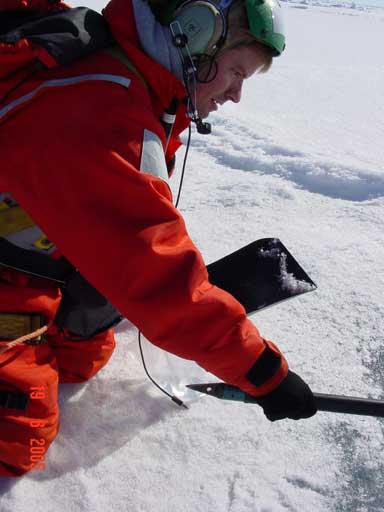 Here I am picking at the ice to see how thick it is. Let’s just say it would have made a good ice-fishing hole. Photo by: Glenn Berger Soon after getting our samples and digging around some, we soon got the tug on our ropes that we had to return to the helicopter since we can only be out a certain amount of time to ensure enough fuel to return to the ship. So, while it didn’t seem like we collected any significant sediment, it was fun to experience our own personal “ice liberty.” We made it back to the helicopter and got in our familiar spots in the back, and took off back for the ship. It was pretty neat to see the ship first come into view as a tiny speck, then get larger and larger through the window of the helicopter. We circled the ship a time or two, then landed safely again on the flight deck, and our adventure on the ice and in the air was now safely completed. Another “first” added to my list of many that I will always remember. Close to Home  The Healy comes into view through the helicopter window Um, I Think We Should Turn Now:)  Getting closer and closer to the Healy Here We Come!  A nice view of the ship from the helicopter. It’s good to see the waterline against the ship at the level where it should be:) |
| Janet_Warburton |
 Jun 21 2005, 06:47 PM Jun 21 2005, 06:47 PM
Post
#2
|
 Project Manager Group: ARCUS Posts: 146 Joined: 29-April 05 From: Fairbanks, Alaska Member No.: 13 |
Totally awesome - what a great "first". I bet you never imagined that someday you would be "standing" on the Arctic Ocean!!
|
| Ute_Kaden |
 Jun 21 2005, 07:01 PM Jun 21 2005, 07:01 PM
Post
#3
|
 TREC Teacher    Group: TREC Team Posts: 203 Joined: 27-April 05 Member No.: 10 |
How cool is this!
Steve, I wait each day to read the news you post. I agree with Janet, "Awesome", you are doing a great job and I encourage everybody I see or can get a hold of to read your log. As for myself, I am wondering what will be in store for me in August? Ute |
| Robert_Oddo |
 Jun 21 2005, 11:54 PM Jun 21 2005, 11:54 PM
Post
#4
|
 TREC Teacher    Group: TREC Team Posts: 165 Joined: 27-April 05 Member No.: 8 |
Wow,
What an experience!!! Bob |
| Leslie_Pierce |
 Jun 22 2005, 02:32 AM Jun 22 2005, 02:32 AM
Post
#5
|
 TREC Teacher    Group: TREC Team Posts: 172 Joined: 27-April 05 Member No.: 7 |
Yes really cool!! So, did you get a little airsick at all with all of the up and down in the helicopter?
Leslie |
| Steve_Marshall |
 Jun 22 2005, 04:42 AM Jun 22 2005, 04:42 AM
Post
#6
|
 TREC Teacher    Group: TREC Team Posts: 78 Joined: 27-April 05 Member No.: 12 |
Thanks for all the comments, everyone. They're really appreciated.
As for the air sickness, Leslie, I really didn't feel any, but even I thought about how that kind of surprised me. As a little kid, I used to be the one to get sick on even the calmest of amusement park rides. Not having felt any sea or air sickness on this trip, I'm wondering if maybe I worked all that out when I was young....or maybe all those amusement park activities were training to get me used to, and prepared for, this! |
  |
2 User(s) are reading this topic (2 Guests and 0 Anonymous Users)
0 Members:

|
NSF Acknowledgment & Disclaimer | Time is now: 15th November 2024 - 05:13 AM |
Invision Power Board
v2.1.7 © 2024 IPS, Inc.








